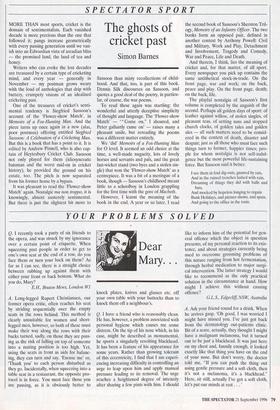SPECTATOR SPORT
The ghosts of cricket past
Simon Barnes
MORE THAN most sports, cricket is the domain of sentimentalists. Each vanished decade is more precious than the one that followed it; pangs increase geometrically with every passing generation until we van- ish into an Edwardian vista of arcadian bliss — the promised land, the land of tea and honey.
Writers who can evoke the lost decades are treasured by a certain type of cricketing mind, and every year — generally in November — my postman grows weary with the load of anthologies that drip with buttery, crumpety visions of an idealised cricketing past.
One of the treasures of cricket's senti- mental tendency is Siegfried Sassoon's account of the 'Flower-show Match', in Memoirs of a Fox-Hunting Man. And the piece turns up once again in a new (alas, poor postman) offering entitled Siegfried Sassoon: A Celebration of a Cricketing Man. But this is a book that has a point to it. It is edited by Andrew Pinnell, who is also cap- tain of Heytesbuty Cricket Club. Sassoon not only played for them (idiosyncratic batsman and the worst mid-on in cricket history), he provided the ground on his estate, too. The pitch is now separated from his former home by a bypass.
It was pleasant to read the 'Flower-show Match' again. Nostalgic ma non troppo, it is knowingly, almost austerely sentimental. But there is just the slightest bit more to
Sassoon than misty recollections of child- hood. And that, too, is part of this book. Dennis Silk discourses on Sassoon, and quotes a good deal of the poetry, in particu- lar, of course, the war poems.
To read these again was startling: the wonderful and utterly deceptive simplicity of thought and language. The 'Flower-show Match' — Come on," I shouted, and Peter gallantly came on' — raises many a pleasant smile, but rereading the poems was a different matter entirely.
We 'did' Memoirs of a Fox-Hunting Man for 0 level. It seemed an odd choice at the time, a well-made nugacity, lots of lovely horses and servants and pals, and the great last-wicket stand (two byes and a stolen sin- gle) that won the 'Flower-show Match' as a centrepiece. It was a bit of a meringue of a book, though — Sassoon's childhood meant little to a schoolboy in London grappling for the first time with the gore of Macbeth. However, I learnt the meaning of the book in the end. A year or so later, I read the second book of Sassoon's Sherston Tril- ogy, Memoirs of an Infantry Officer. The two books form an opposed pair, defined in another context by Anthony Powell: Civil and Military, Work and Play, Detachment and Involvement, Tragedy and Comedy, War and Peace, Life and Death.
And therein, I think, lies the meaning of cricket and, for that matter, of all spirt. Every newspaper you pick up contains the same antithetical stock-in-trade. On the front page, war and work; on the back, peace and play. On the front page, death; on the back, life.
The playful nostalgia of Sassoon's first volume is completed by the anguish of the second. Perhaps all golden days of sport: of leather against willow, of stolen singles, of pleasant teas, of setting suns and stopped church clocks, of golden tales and golden ales — all such matters need to be consid- ered in the context of death, disaster and despair; just as all those who must face such things turn to former, happier times; peo- ple for whom nostalgia is not self-indul- gence but the most powerful life-sustaining force. But Sassoon said it better.
I see them in foul dig-outs, gnawed by rats, And in the ruined trenches lashed with rain, Dreaming of things they did with balls and
bats, And mocked by hopeless longing to regain Bank Holidays, and picture-shows, and spats, And going to the office in the train.


















































































 Previous page
Previous page